Math at ACA
John Milton Gregory’s The Seven Laws of Teaching, first published in 1886, forms the cornerstone of teaching and curriculum decisions at ACA, and if you look closely, you’ll find these laws posted in every ACA classroom. According to Gregory, teachers must: 1) know the material they wish to teach, 2) gain and keep the interest of the students, 3) use language that is familiar to the students, 4) begin with prior knowledge and attach new learning to prior knowledge, 5) stimulate the students’ minds to action, 6) require students to reproduce what they have learned in their own words, and finally 7) review continuously.
Having a brief understanding of Gregory’s laws and their influence at ACA is the foundation of understanding all of our teaching practices and curriculum choices.
With this in mind, let’s take a closer look at ACA’s math curriculum. For our grammar and upper school, we primarily use Saxon Math. In second and third grade, we use Classical Math published by Logos Press.
John Saxon (1923-1996), writer and publisher of Saxon Math, was a graduate of West Point Academy and earned several degrees in engineering, both electrical and aeronautical. He became a math teacher, textbook writer, and publisher after retiring from the Air Force. While teaching math at a junior college, he realized that most of his students were woefully unprepared in their K-12 education to do basic algebra. Out of this was born the Saxon method. He rejected the idea that students could be divided into two groups: those who were “math people” and those who weren’t. He knew that if he could break math down into incremental steps, all students could be successful in math.
The Saxon method meets all of Gregory’s laws of teaching. The math teacher knows the material to be taught because each day introduces an incremental step in a math concept. Students can easily attach new learning to yesterday’s lessons as they are shown each step and are provided with sufficient practice. Each lesson either starts with a morning meeting or a math puzzle, both of which are always popular with students. From my own experience teaching Saxon Math in 5th and 6th grades, these math puzzles were the highlight of the lesson. Students would race to see who could solve the puzzle first, which gave a nice shot of energy at the start of each class. Additionally, the language in each level of Saxon is suited for their ascribed grade level. The teacher teaches the lesson, which is short, and students are quickly able to get to work. Students are required to show their work, and, best of all, Saxon continuously reviews past concepts.
You’ve most likely have heard teachers use the word “spiraling” when talking about Saxon math. This term describes the incremental and continuous review approach of the curriculum. Students are introduced to a small new concept, they practice that concept, and then they review, review, and review. Saxon Math also uses frequent assessments, which gives regular feedback to both teachers and students on what is being learned and retained, and on what concepts need more work before students get too far behind. This is key. Math is a skill and a language that continuously builds on prior learning, and it must be used and practiced in this way in order to be absorbed. Math is not learned when concepts are given to students in large chunks and then rarely reviewed. Instead, math is truly learned when it becomes automatic by consistent practice and review.
Classical Math by Logos Press is used in the second and third grades. As the name suggests, the curriculum uses a classical approach for the grammar stage: lots of chants, skip counting, and continuous review. Written by a veteran math teacher with over 20 years of experience, Classical Math teaches students to pay attention to detail, read directions with care, and to be consistent with their work. The focus of these years is to solidify knowledge of math facts and fact families. This curriculum was specifically designed for students taught with Saxon Math in kindergarten and first grade and returning to Saxon in fourth grade.
John Saxon once said, “Results, not methodology, should be the basis for curriculum decisions. Results matter.” We agree. Results matter, and Saxon Math and Classical Math are giving ACA great results. God created and gave us math, and we love passing this gift on to our students by using these two time-tested and research-backed curriculums that make math accessible to all.
